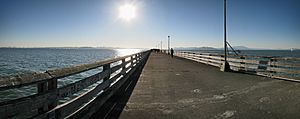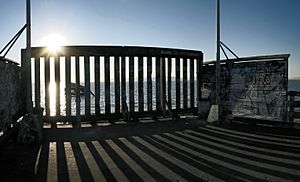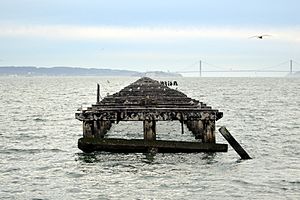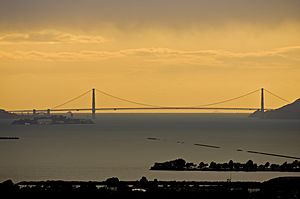Berkeley Pier facts for kids

The Berkeley Pier is a famous pier located in Berkeley, California. When it was first built in 1926, the pier stretched about 3.5 miles (5.6 km) into San Francisco Bay. It started from the end of University Avenue. Over time, parts of the bay were filled in, and the Berkeley Marina was created. Because of these changes, the pier is now only about 2.5 miles (4.0 km) long.
For many years, only the first 3,000 feet (910 m) of the pier were kept in good condition and open to the public. However, in July 2015, the pier was closed to everyone. This happened because there were worries about how safe it was.
Contents
History of the Berkeley Pier
Early Wharves and City Plans
Long ago, in the mid-1800s, there were two private wharves (small piers) along the Berkeley waterfront. One was used by a soap factory. The other, called the Jacobs and Heywood Wharf, helped move goods from one place to another.
In 1909, the City of Berkeley built its own wharf at University Avenue. This wharf was meant for a ferry that would carry people, but that ferry never started. Instead, the wharf was mostly used for moving freight.
Building a New Ferry Pier
In 1925, a company called the Golden Gate Ferry Company had a big idea. They wanted to build a new pier for car ferries that would travel between Berkeley and San Francisco. The City of Berkeley agreed to let them use the bay land for 50 years to build this new pier.
The Golden Gate Ferry Company asked for permission to start their ferry service in January and July of 1926. They received the approval they needed.
Later in 1926, construction began on the Berkeley Pier. It was built from University Avenue and went about 3.5 miles (5.6 km) into the bay. This long distance was needed to reach deeper water for the ferries. Most of the pier was a paved, two-lane road. At the very end, the pier became wider. This allowed many cars to wait for the ferry at the same time. Two ferry docks were also built there.
Ferry Service Begins
On June 16, 1927, the car ferry service officially started. Ferries traveled between the Berkeley Pier and the Hyde Street Pier in San Francisco. The Hyde Street Pier was also used by ferries going to Sausalito.
In December 1928, the Golden Gate Ferry Company decided to join with another ferry company, the Southern Pacific railroad. They asked for permission to merge. On February 18, 1929, the new company, called Southern Pacific-Golden Gate Ferries Ltd., was formed. This new company took over the ferry service from Berkeley Pier on May 1, 1929.
When the service first started, four special diesel ferry boats were used. They ran every 15 minutes between Berkeley and San Francisco. Their names were the Golden Bear, the Golden Poppy, the Golden State, and the Golden Dawn. All of them were painted yellow. After the merger, the boats were repainted white, like other Southern Pacific boats.
In August 1928, a radio station named KTAB also built its broadcasting equipment and a large antenna tower at the pier.
The Pier's Role and Closure
From its opening in 1927 until 1937, the Berkeley Pier was a very important part of travel. It was part of the Lincoln Highway, which was the first road to cross America. Later, it became part of U.S. Route 40.
The ferry service stopped on October 16, 1937. This happened about 11 months after the Bay Bridge opened for cars. People could now drive across the bay instead of taking a ferry.
After the ferries stopped, the part of the pier closest to the shore was used for fun activities. Many people enjoyed fishing there. The rest of the pier was left alone and slowly fell apart. You can still see this old, unused part, but you cannot reach it because of a barrier. There is a small gap at the end of the open pier. This gap allows small boats to pass through. In 2007, there were ideas to start a new ferry service from a terminal near the pier.
In 2015, the pier was getting old and damaged. Because of this, the entrance was fenced off to keep people safe.
See also
- Ferries of San Francisco Bay







